Abstract
With an influx of public and private sector investment in the electric vehicle (EV) domain, public agencies and stakeholders need objective, equitable and systematic processes for identifying candidate sites for siting charging stations. This paper reports on a case study examining the Indiana Interstate network using connected vehicle data (CV). The Indiana Interstate network analyzed by this study is composed of 1247 centerline miles along nine routes. Each month, approximately 13 billion CV records representing more than 44 million unique trips are generated along all roads in Indiana. For this study 3.02 billion records comprising 4.78 million trips on and around Indiana Interstates and Exits were analyzed for usage patterns. The CV data was predominantly from internal combustion engine vehicle (ICEV) passenger cars, but provides insight into exit utilization and dwell times at 544 exits on 9 interstate roadways to evaluate how their current usage would align with building out Indiana’s Alternative Fuel Corridors. A pareto sorted graphic for the top 50 busiest exits in the state shows that all but two are not well served by fast charging infrastructure. The paper suggests this pareto sorted list as a good starting point for further analysis and identified 15 exits on Indiana interstates, if chosen for deploying charging infrastructure, would ensure full compliance. The results provide a systemwide look at present dwell patterns among ICEVs and help identify locations of interest that would most benefit from addition of charging infrastructure as the current fleet of ICEVs gradually transitions to EVs.
1. Introduction
The US Departments of Transportation (USDOT) and Energy announced in early 2022 the appropriation of $7.5 billion towards building out a nationwide electric vehicle (EV) charging network in an effort to improve charging accessibility for all Americans [1]. The underlying Bipartisan Infrastructure Law that led to this announcement represents the highest ever investment in EV charging by the federal government with $5 billion in formula funding and an additional $2.5 billion made available to states through competitive grants [2,3,4]. As states now begin the gradual process of identifying how and where to build out their network of charging stations, historical investment has seen charging infrastructure being concentrated in high-income urban and early EV adopter concentration areas [5]. However, with a long-term goal set by the USDOT to have charging infrastructure made equitably available, a novel approach is needed to determine equitable and maximally accessible placement of charging stations to align with Alternative Fuel Corridor (AFC) requirements. With limited charging availability being one of the foremost barriers to EV adoption [6,7], this study shows how connected vehicle (CV) data can be used to make informed choices for EV infrastructure investments.
1.1. Literature Review
A top priority for stakeholders is deciding where to site electric vehicle charging stations to ensure maximum accessibility and equitable distribution. Most states have multiple interstate routes with exits numbering in the hundreds and need systematic procedures to analyze candidate exits for siting charging stations. The first step in this process involves identifying a candidate interstate exit.
There have been a limited number of studies that have looked at using CV trajectory data for analyzing exit or entry ramp usage for limited access roadways. A study on route choice around planned and unplanned freeway closures in Indiana looked at scalably utilizing CV data towards computing ramp delay experienced by vehicles leaving the interstate, and percentage of the traffic stream departing a freeway corridor at every single exit [8]. Such methodologies may be further built upon and extended to compute exit usage metrics presenting planners with a detailed look at the level of usage each interchange observes on a state’s freeway system. Having access to these performance metrics for interstate exits affords decision makers the ability to quickly filter and shortlist locations of interest that may most benefit from additional charging infrastructure based on observed usage rather than solely relying on current levels of EV adoption concentration to select charging station sites.
Due to the absence of actionable EV data to inform decision-making, perhaps due to low penetration levels [9], modeling and simulation have been the primary tools of choice for designing optimal charging station site selection strategies [10,11,12]. These studies have generally focused on localized charging station siting problems [13,14,15,16] with emphasis on a population density, parking availability, power grid demands and reliability, traffic conditions, land acquisition costs, and charging fees. Multiple studies have also used spatially and temporally selected connected fleet vehicle datasets and agent-based modeling to assess charging patterns and charging station usage at the local level [17,18]. However, when allocating funding at the federal and state level, a more comprehensive and holistic system-level analysis is necessary to first identify candidate exit locations which can then be further analyzed by the aforementioned parameters on a local level for determining hyperlocal optimal charging station placement.
Research has highlighted the need for having a non-clustered and widely available network of fast charging infrastructure to equitably serve all road users. For example, the metropolitan area of Chicago sees high clustering of charging stations in the affluent sections of the city requiring EV users from other neighborhoods with low charging accessibility to travel out of their way to gain access to charging facilities [19]. A July 2021 study observed only 75% of DC Fast charging stations were accessible within 1 mile of interstate roadways in Indiana [20], a metric that has since been adopted by the USDOT to ensure a state’s proposed deployment plan complies with the NEVI program formula guidance [21].
While several approaches exist at the local level to optimally site charging stations, a system-level approach that considers current travel behavior among ICEVs as a surrogate for future EV travel is missing. This study presents a methodology and case study using CV data to identify charging station infrastructure investment allocation opportunities.
1.2. Objectives and Scope
The scope of this study is to develop and present methodologies by which CV trajectory waypoint data may be used to assess interstate exit utilization and thus identify where charging infrastructure investments are needed. The methodologies and analyses presented in the sections that follow broadly cover the following two objectives:
- Analyzing exit usage on Indiana’s interstate network
- Analyzing CV dwell patterns in the vicinity of interstate exits
1.3. Study Location
The interstate routes chosen for this analysis include 9 of Indiana’s interstates (namely I-64, I-65, I-69, I-70, I-74, I-90, I-94, I-265 and I-469) and includes 544 exits overall. A spatial representation of the routes analyzed (black lines) and the corresponding exits (blue circles) can be seen in Figure 1. Interstate 465, a heavily used commuter beltway around the city of Indianapolis was excluded from the analysis due to its short 53-mile length, urban setting and ample availability of fast charging stations in its vicinity. The region of analysis was approximately chosen to extend 5 miles away in either direction from an interstate assuming this as a realistic threshold of distance traveled by a CV for a short break.
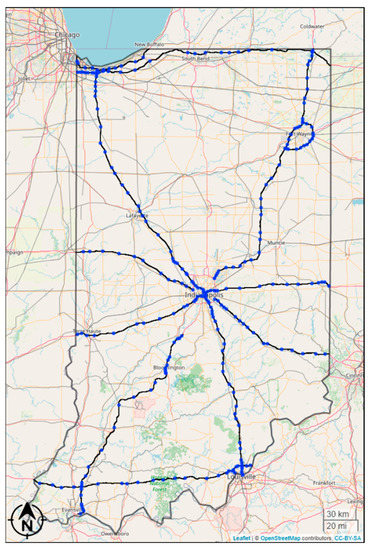
Figure 1.
Overview map of 9 interstate corridors (black lines) and 544 exits (blue dots).
1.4. CV Data
CV data obtained from a third-party vendor at 3-s frequency and 3 m geolocation accuracy was utilized for this study. Each CV data record represents a CV waypoint with the following attached attributes—an anonymized trajectory identifier, speed, heading, geolocation, timestamp, ignition status, and a vehicle classification code allowing the categorization of the waypoint as belonging to an ICEV, hybrid vehicle (HV) or EV. Each month, Indiana ingests nearly 13 billion CV records representing over 44 million unique trips of sampled CVs. This dataset represents on average about 4.3% of traffic volumes on interstates and 5% of volumes on non-interstate roads [22]. Of these 44 million trips for the month of May 2022, 4.78 million trips were observed to have occurred within the nominally 5-mile spatial buffer around the 9 interstate routes analyzed in this study, representing about 3 billion CV trajectory waypoints. In total, 1.06 billion records out of the above dataset were observed directly on interstate roadways, which enabled the exit utilization and dwell session computations described by the sections that follow in greater detail. A flowchart representation highlighting the scale of CV data used in this analysis is depicted by Figure 2. While the data used in this study mainly represents ICEVs, exit usage and dwell activity patterns obtained from the same may be used as a surrogate for future EV travel as the composition of current ICEV heavy traffic slowly transitions towards majority EVs in the near future.
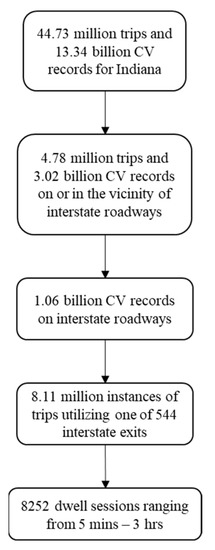
Figure 2.
Scale of CV Big Data for Indiana (May 2022).
2. Methodology
2.1. Analyzing Interstate Exit Usage
Given a comprehensive dataset of CV waypoints for the state of Indiana, the first step to reduce the waypoint data down to exit-level metrics is analyzing every single CV trajectory to determine points of ingress and egress off of an interstate route. The methodology utilized by this paper involves a set of polygons, each 0.1 mile in length, along the direction of travel of a roadway pointed to by callout ii in Figure 3. A CV trajectory’s overlap is determined with this set of polygons, enabling the detection of the point of departure for a journey when it leaves the interstate. This linearly referenced set of polygons allows a near-exact detection of the mile marker, and thus the corresponding exit, at which a journey joined or left the interstate route. For the sample journey shown by the red waypoints in Figure 3, callout i shows the point at which the journey departs the interstate. Hence, using this methodology for the sample CV trip shown in Figure 3, it can be classified as having exited off of interstate 64 (I-64) at Exit 92.
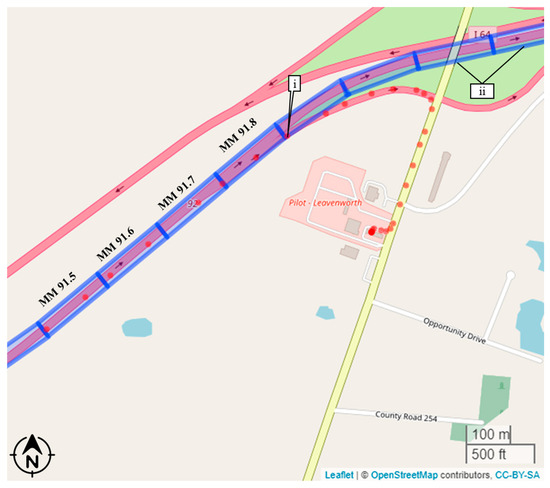
Figure 3.
Sample CV trajectory departing I-64 at Exit 92 showing methodology for detecting exit usage.
Using the aforementioned methodology, a comprehensive analysis was conducted for I-64 using CV data for the month of May 2022. The number of unique CV trips utilizing each exit can be seen geographically ordered in Figure 4a and pareto sorted by usage in Figure 4b. Exit 121 shows the highest usage due to it being a major interchange connecting I-64 to another major interstate I-265 which is a heavily used beltway around the northern half of the city of Louisville. Exit usage is also seen to increase near Exits 25 and 29, and towards the eastern edge of the interstate which are close to the population centers of Evansville and Louisville, respectively.
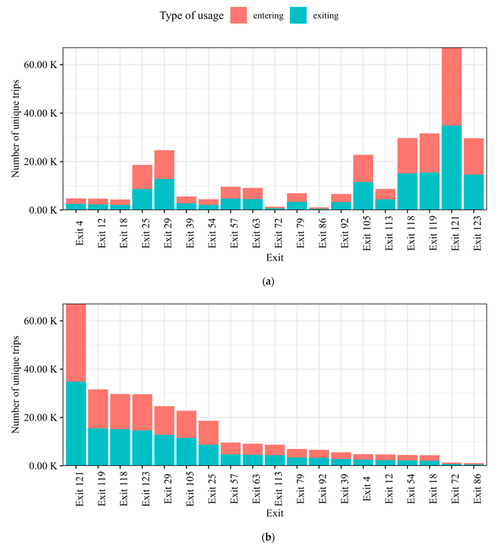
Figure 4.
Exit Utilization for 19 exits on Interstate 64 (May 2022). (a) Exits ordered geographically. (b) Exits ordered by observed usage.
2.2. Analyzing Dwell Patterns
Having detected a trip that has left or joined an interstate route, the next step is detecting whether the CV has dwelled for a short time (limited from 5 min to 3 h for this study) at an interstate exit after leaving and before rejoining the interstate. An 11-state study for the month of August 2021 first explored the use of CV waypoint data towards detecting charging station usage by analyzing EV trips within 100 feet of a charging station [23]. That methodology has been extended by this study to observe dwell sessions among all passenger vehicles at any location in the vicinity of an interstate. A search area of six miles using a five-character geohash is used to find dwell sessions [24]. A complete analysis of exit utilization and dwell sessions was conducted for I-64 summarized by the graphics in Figure 5. Exit 121 sees the highest utilization (Figure 5a), with Exits 121 and Exit 123 showing relatively higher median dwell times (Figure 5b), while Exit 25 on the other hand shows the highest number of dwell sessions (Figure 5c). Evidently, Exit 25 is adjacent to four gas stations and a number of restaurants, while Exit 121 is a ramp connecting to another interstate and Exit 123 accesses surface level streets before a bridge to Kentucky. Corridor-level graphics such as these may help stakeholders quickly identify exits of interest based on a combination of a high number of dwell sessions and low dwell times to site fast charging locations.
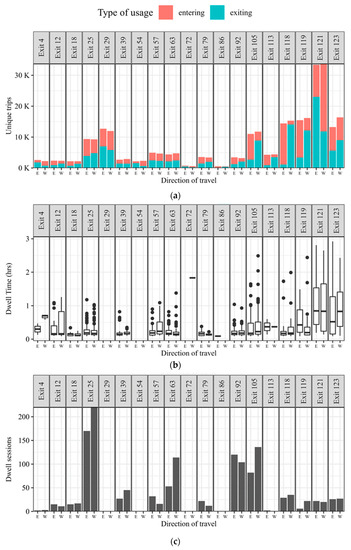
Figure 5.
Exit Utilization and Observed Dwell Activity for Interstate 64 (May 2022). (a) Exit Utilization by Direction of Travel. (b) Dwell Times observed across 19 exits. (c) Number of Dwell Sessions at each exit.
2.3. Scaling Methodology for Systemwide Analysis
These data analytics procedures scale quite well. A systemwide analysis of all 544 exits along 9 interstates was carried out using CV data for Indiana for the month of May 2022. The results of the exit utilization analysis are shown in Figure 6 as a pareto sorted chart of the top 50 exits with the highest CV activity. Trips utilizing each exit are categorized by those joining the interstate (entering) or those leaving the interstate route (exiting). Callout i points to the most utilized exit in the state, Exit 201 on Interstate 69, which is, unsurprisingly, a major interchange connecting Interstate 69 with Interstate 465, the beltway around the city of Indianapolis witnessing heavy commuter traffic on a daily basis.
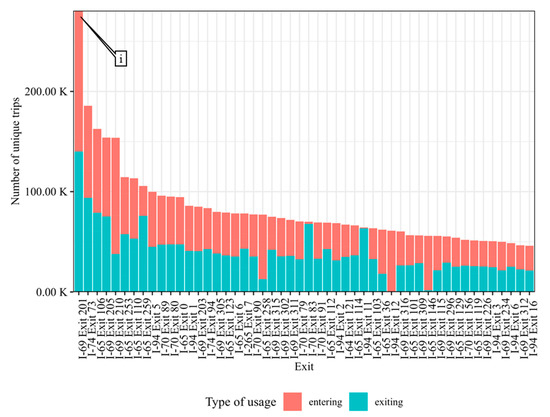
Figure 6.
Top 50 Utilized Exits on Indiana’s Interstates (May 2022).
A statewide heatmap shown in Figure 7 depicts an overall spatially aggregated view of dwell session activity (8252 dwell sessions in total) along the routes analyzed by this study. Major metropolitan areas such as Indianapolis, Fort Wayne, Gary, Bloomington, Louisville, Evansville and Terre Haute, a number of which are border towns in Indiana with the neighboring states of Illinois, Michigan, Ohio and Kentucky clearly depict high dwell session numbers. In addition to high dwell locations, the map also offers insights into discernible rural interstate locations witnessing minimal dwell activity. While such locations may currently not be heavily used by the motoring public, they may present opportunities to state transportation agencies to infuse economic development in the region while ensuring the provision of equitable access to charging infrastructure to underserved locations at the same time.
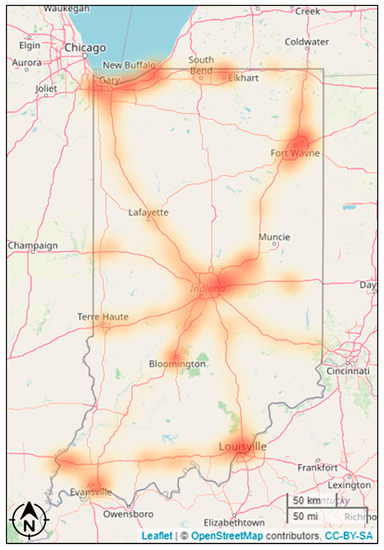
Figure 7.
Overview heatmap of 8252 recorded dwell sessions near Interstates (May 2022).
A pareto sorted representation showing the top 50 exits in the study location ranked by the number of dwell sessions observed at each exit is shown in Figure 8. Hollow white columns indicate exits that currently have a fast charging station within one mile of the interstate, solid black columns indicate exits without any fast charging stations within a one-mile radius of the exit, while hatched columns represent those exits forming a major interchange with another interstate route. This graphic depicts how a majority of the top 50 utilized exits in the state, as of this analysis, are not sufficiently serviced by fast charging infrastructure except for Exit 22 on I-94.
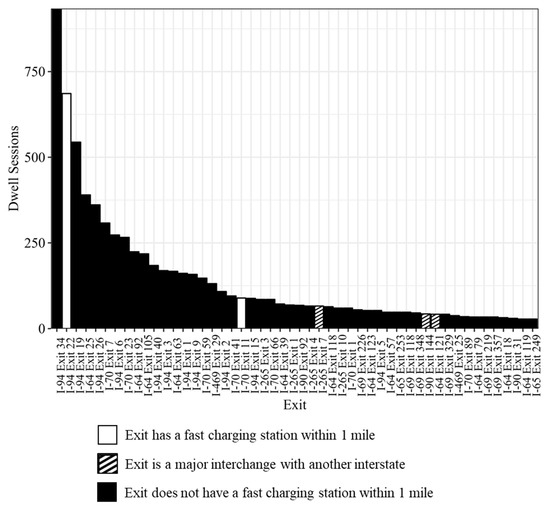
Figure 8.
Top 50 Exits with highest recorded number of dwell sessions (May 2022).
A tabular summary of the top three exits for each analyzed route seeing the highest number of dwell sessions is shown in Table 1, along with the number of dwell sessions (NDS) and mean dwell time (MDT) in hours corresponding to each exit. Exit 34 on Interstate 94 shows the highest number of dwell sessions overall (934), while Exit 249 on Interstate 65 shows the highest overall mean dwell time (1.32 h). Exit 34 on I-94 is home to multiple lodging options, restaurants, convenience and department stores within a mile pointing to possible reasoning for it accounting for the highest number of dwell sessions. Exit 249 on I-65 has multiple long-term dwell options including dining and shopping within a mile possibly accounting for the highest overall MDT among all exits.

Table 1.
Summary of number of dwell sessions and dwell times for top three exits on each analyzed interstate route (May 2022).
2.4. Proposed Exit Selection Methodology to Address Fast Charging Deserts
To identify equitable charging infrastructure investments, the top three most used exits for an interstate route may not be the optimal locations to site charging stations. This is due to a number of reasons, key among them being that the most used exits will invariably fall in urban areas seeing heavy traffic volumes, but focusing on them may leave rural stretches of interstate unattended and underserved. This in turn does little to help an Alternative Fuel Corridor (AFC) provide equitable charging throughout or alleviate range anxiety among EVs. Table 2 presents one possible configuration of exit choices that may help alleviate the fast charging deserts on the routes analyzed by this study and shows the statewide as well as corridor wide rank for each exit in terms of number of dwell sessions. A fast charging desert, as defined in existing literature [20,23], refers to a stretch of roadway 50 miles or longer with no fast charging availability within 1 mile of the road.

Table 2.
Proposed list of 15 exits, if reinforced with fast charging infrastructure within 1 travel mile of interstate, that would ensure NEVI compliance for each route to be designated an Alternative Fuel Corridor (AFC).
Number of dwell sessions (NDS) and mean dwell time (MDT) observed at each of these exits are also shown by corresponding columns in Table 2. These exits were chosen by visual inspection of the systemwide analysis charts, to ensure that exits with the highest number of dwell sessions were picked that also help the overall corridor satisfy the NEVI requirement of having EV charging infrastructure installed every 50 miles within 1 mile of the interstate. Of course, more formalized prioritization criteria could be adopted once there is consensus on quantitative exit attributes that should be considered to maximize both equity and usage.
Figure 9 illustrates a pareto sorted representation of all 198 exits witnessing one or more dwell sessions in May 2022. Among the 198 exits, those exits chosen in Table 2 to add additional charging capacity to, are highlighted by hollow white columns as well as individually called out. This figure goes to show that the exits that may need to be chosen for ensuring NEVI Formula compliance may not necessarily be the exits that are currently being used the most, but may present an opportunity for infusing economic development in rural sections while ensuring widespread access to charging.
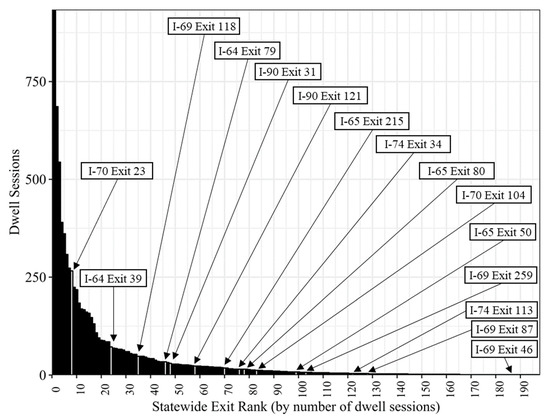
Figure 9.
Statewide Rank of Exits chosen in Table 2 to ensure NEVI Compliance for AFCs.
Figure 10a shows a statewide map of the current state of fast charging infrastructure in Indiana. The charging stations shown herein, made available via the National Renewable Energy Laboratory’s (NREL) Alternative Fuel Station API [25], represent those with the SAE J1772, SAE J1772 Combined Charging System (CCS) Combo 1 and CHAdeMO fast charging connectors only. Blue circles represent locations of existing fast charging stations, while red lines represent fast charging deserts on an interstate route.
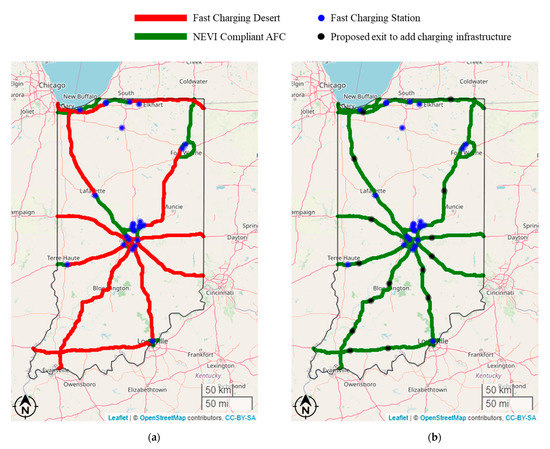
Figure 10.
Indiana Interstate Fast Charging Deserts. (a) Current state of fast charging infrastructure in Indiana. (b) Charging deserts addressed by potential addition of infrastructure at exits proposed in Table 2.
Black circles shown in Figure 10b represent proposed exits from Table 2 which if reinforced with fast charging capacity within a mile of the interstate, would together rid Indiana’s Interstate system of any fast charging deserts and ensure each shown route is in compliance with the NEVI Program formula guidance. While the proposed exits shown herein may only present one of many possible exit configurations to fully address the charging deserts problem, they provide a framework for stakeholders in being able to leverage CV data and provide the quantitative evidence that could inform such investment and resource allocation decisions based on measured surrogate demand.
3. Conclusions
Identifying candidate interstate exits for siting EV charging stations is a top priority for stakeholders to ensure equitable utilization and disbursement of NEVI program funding. While multiple approaches exist for localized identification of optimal charging station sites, the current state of the art is missing a system-level approach towards leveraging widely available CV data towards informing such decision-making. This study, and the methodologies proposed in preceding sections, aimed to address this research gap. This study analyzed over 3 billion CV records representing nearly 4.78 million trips in the vicinity of 9 interstate routes in Indiana for the month of May 2022 (Figure 2) to analyze exit utilization and dwell patterns. Easily scalable methodologies using CV trajectory waypoint data that enable the computation of exit utilization and dwell session metrics for any corridor, provided the availability of data and free of any spatial or temporal sensor infrastructure constraints, were presented. The top 50 exits in the state of Indiana out of a total of 544 exits analyzed were highlighted to show those witnessing the most usage (Figure 6) as well as the highest number of dwell sessions in their vicinity (Figure 8). A high percentage of these exits are primarily located in urban areas that observe heavy traffic volumes, and are also not currently serviced well by fast charging infrastructure. In fact, Figure 8 showing pareto sorted utilization for the top 50 busiest exits in the state shows that all but two are not well served by fast charging infrastructure.
Using ICEV usage data, this study identifies 15 exits along the analyzed routes which if instrumented with additional fast charging capacity would alleviate the fast charging desert problem (Figure 10) and ensure Indiana’s AFCs are compliant with federal requirements. The selected exits and their relative position in a statewide ranking of all exits (Figure 9, Table 2) highlight the need for choosing rural and underused interstate exits as well to ensure equitable build out of charging infrastructure to alleviate range anxiety among EV users.
The methodologies, subsequent analysis and visualizations presented by this study showcase the applicability of CV data towards scalably and systematically analyzing exits on a road network to inform charging infrastructure investment allocation opportunities. While the dataset used majorly hails from ICEVs, the exit usage and dwell patterns found from it could very well be used as a surrogate for future EV travel assuming the current mix of traffic shifts to a majority EV concentration in the near future. Future studies in this domain may involve comparative analysis between dwell sessions at gas stations compared to those at charging stations to define performance metrics that would allow stakeholders to strategically plan as well as quantify the impact of their investment in EV charging infrastructure.
Author Contributions
Conceptualization, J.D., J.K.M., H.L. and D.M.B.; Data curation, J.D. and H.L.; Formal analysis, J.D., J.K.M., H.L. and D.M.B.; Funding acquisition, D.M.B.; Investigation, J.D., J.K.M., H.L. and D.M.B.; Methodology, J.D., J.K.M., H.L. and D.M.B.; Project administration, D.M.B.; Resources, D.M.B.; Software, H.L.; Supervision, J.K.M., H.L. and D.M.B.; Validation, J.D., J.K.M. and H.L.; Visualization, J.D., J.K.M. and H.L.; Writing—original draft, J.D., J.K.M., H.L. and D.M.B.; Writing—review and editing, J.D., J.K.M., H.L. and D.M.B. All authors have read and agreed to the published version of the manuscript.
Funding
This study is based upon work supported by the ASPIRE award, an Engineering Research Center program by the National Science Foundation (NSF), grant no. EEC-1941524, and the Joint Transportation Research Program administered by the Indiana Department of Transportation and Purdue University.
Acknowledgments
CV Trajectory data between 1 May and 30 May 2022 used in this study was provided by Wejo Data Services Inc. Google Cloud Platform’s Big Query was utilized for the cloud database analysis and warehousing. The contents of this paper reflect the views of the authors, who are responsible for the facts and the accuracy of the data presented herein, and do not necessarily reflect the official views or policies of the sponsoring organizations. These contents do not constitute a standard, specification, or regulation.
Conflicts of Interest
The authors declare no conflict of interest.
References
- USDOT. President Biden, USDOT and USDOE Announce $5 Billion over Five Years for National EV Charging Network, Made Possible by Bipartisan Infrastructure Law|FHWA. Available online: https://highways.dot.gov/newsroom/president-biden-usdot-and-usdoe-announce-5-billion-over-five-years-national-ev-charging (accessed on 17 July 2022).
- The White House. FACT SHEET: The Biden-Harris Electric Vehicle Charging Action Plan. Available online: https://www.whitehouse.gov/briefing-room/statements-releases/2021/12/13/fact-sheet-the-biden-harris-electric-vehicle-charging-action-plan/ (accessed on 17 July 2022).
- The White House. FACT SHEET: Biden-Harris Administration Proposes New Standards for National Electric Vehicle Charging Network. Available online: https://www.whitehouse.gov/briefing-room/statements-releases/2022/06/09/fact-sheet-biden-harris-administration-proposes-new-standards-for-national-electric-vehicle-charging-network/ (accessed on 23 August 2022).
- The White House. FACT SHEET: Biden-Harris Administration Catalyzes More than $700 Million in Private Sector Commitments to Make EV Charging More Affordable and Accessible. Available online: https://www.whitehouse.gov/briefing-room/statements-releases/2022/06/28/fact-sheet-biden-harris-administration-catalyzes-more-than-700-million-in-private-sector-commitments-to-make-ev-charging-more-affordable-and-accessible/ (accessed on 23 August 2022).
- Kampshoff, P.; Kumar, A.; Peloquin, S.; Sahdev, S. America’s Electric-Vehicle Charging Infrastructure|McKinsey. Available online: https://www.mckinsey.com/industries/public-and-social-sector/our-insights/building-the-electric-vehicle-charging-infrastructure-america-needs (accessed on 18 July 2022).
- Tolbert, J. Beyond Cities: Breaking Through Barriers to Rural Electric Vehicle Adoption|Article|EESI. Available online: https://www.eesi.org/articles/view/beyond-cities-breaking-through-barriers-to-rural-electric-vehicle-adoption (accessed on 18 July 2022).
- Seattle, O.S.E. Removing Barriers to Electric Vehicle Adoption by Increasing Access to Charging Infrastructure. Alternative Fuel Toolkit. 2014. Available online: https://altfueltoolkit.org/resource/removing-barriers-to-electric-vehicle-adoption-by-increasing-access-to-charging-infrastructure/ (accessed on 9 August 2022).
- Desai, J.; Scholer, B.; Mathew, J.K.; Li, H.; Bullock, D.M. Analysis of Route Choice During Planned and Unplanned Road Closures. IEEE Open J. Intell. Transp. Syst. 2022, 3, 489–502. [Google Scholar] [CrossRef]
- Lambert, F. Global Market Share of Electric Cars More than Doubled in 2021 as the EV Revolution Gains Steam. Electrek. 2022. Available online: https://electrek.co/2022/02/02/global-market-share-of-electric-cars-more-than-doubled-2021/ (accessed on 9 August 2022).
- Hosseini, S.; Sarder, M. Development of a Bayesian Network Model for Optimal Site Selection of Electric Vehicle Charging Station. Int. J. Electr. Power Energy Syst. 2019, 105, 110–122. [Google Scholar] [CrossRef]
- Liu, H.-C.; Yang, M.; Zhou, M.; Tian, G. An Integrated Multi-Criteria Decision Making Approach to Location Planning of Electric Vehicle Charging Stations. IEEE Trans. Intell. Transp. Syst. 2019, 20, 362–373. [Google Scholar] [CrossRef]
- Lam, A.Y.S.; Leung, Y.-W.; Chu, X. Electric Vehicle Charging Station Placement: Formulation, Complexity, and Solutions. IEEE Trans. Smart Grid 2014, 5, 2846–2856. [Google Scholar] [CrossRef]
- Chen, T.D.; Kockelman, K.M.; Khan, M. Locating Electric Vehicle Charging Stations: Parking-Based Assignment Method for Seattle, Washington. Transp. Res. Rec. 2013, 2385, 28–36. [Google Scholar] [CrossRef]
- Kong, W.; Luo, Y.; Feng, G.; Li, K.; Peng, H. Optimal Location Planning Method of Fast Charging Station for Electric Vehicles Considering Operators, Drivers, Vehicles, Traffic Flow and Power Grid. Energy 2019, 186, 115826. [Google Scholar] [CrossRef]
- Mao, D.; Tan, J.; Wang, J. Location Planning of PEV Fast Charging Station: An Integrated Approach Under Traffic and Power Grid Requirements. IEEE Trans. Intell. Transp. Syst. 2021, 22, 483–492. [Google Scholar] [CrossRef]
- Huang, Y.; Kockelman, K.M. Electric Vehicle Charging Station Locations: Elastic Demand, Station Congestion, and Network Equilibrium. Transp. Res. Part D: Transp. Environ. 2020, 78, 102179. [Google Scholar] [CrossRef]
- Cai, H.; Jia, X.; Chiu, A.S.F.; Hu, X.; Xu, M. Siting Public Electric Vehicle Charging Stations in Beijing Using Big-Data Informed Travel Patterns of the Taxi Fleet. Transp. Res. Part D Transp. Environ. 2014, 33, 39–46. [Google Scholar] [CrossRef]
- Speidel, S.; Bräunl, T. Driving and Charging Patterns of Electric Vehicles for Energy Usage. Renew. Sustain. Energy Rev. 2014, 40, 97–110. [Google Scholar] [CrossRef]
- Carlton, G.J.; Sultana, S. Electric Vehicle Charging Station Accessibility and Land Use Clustering: A Case Study of the Chicago Region. J. Urban Mobil. 2022, 2, 100019. [Google Scholar] [CrossRef]
- Desai, J.; Mathew, J.K.; Li, H.; Bullock, D.M. Analysis of Electric and Hybrid Vehicle Usage in Proximity to Charging Infrastructure in Indiana. J. Transp. Technol. 2021, 11, 577–596. [Google Scholar] [CrossRef]
- Alternative Fuels Data Center: National Electric Vehicle Infrastructure (NEVI) Formula Program. Available online: https://afdc.energy.gov/laws/12744 (accessed on 18 July 2022).
- Hunter, M.; Mathew, J.; Cox, E.; Blackwell, M.; Bullock, D. Estimation of Connected Vehicle Penetration Rate on Indiana Roadways. JTRP Affil. Rep. 2021, 37. [Google Scholar] [CrossRef]
- Desai, J.; Mathew, J.K.; Li, H.; Bullock, D.M. Using Connected Vehicle Data for Assessing Electric Vehicle Charging Infrastructure Usage and Investment Opportunities. Inst. Transp. Eng. ITE J. 2022, 92, 22–31. [Google Scholar]
- Vukovic, T. Hilbert-Geohash—Hashing Geographical Point Data Using the Hilbert Space-Filling Curve. Master’s Thesis, NTNU, Trondheim, Sweden, 2016. [Google Scholar]
- NREL. Alternative Fuel Stations API|NREL: Developer Network. Available online: https://developer.nrel.gov/docs/transportation/alt-fuel-stations-v1/ (accessed on 18 July 2022).
Publisher’s Note: MDPI stays neutral with regard to jurisdictional claims in published maps and institutional affiliations. |
© 2022 by the authors. Licensee MDPI, Basel, Switzerland. This article is an open access article distributed under the terms and conditions of the Creative Commons Attribution (CC BY) license (https://creativecommons.org/licenses/by/4.0/).